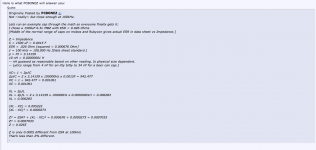I'm wondering what the difference is between Low ESR caps and Low Impedance caps and which one would be best for power supply smoothing.
I'm guessing that audio grade caps are designed for signal applications like cathode resistor bypass or coupling. That a low ESR cap would be better in a low voltage filter or smoothing application like DC heater supplies. Is that a fair statement?
I'm guessing that audio grade caps are designed for signal applications like cathode resistor bypass or coupling. That a low ESR cap would be better in a low voltage filter or smoothing application like DC heater supplies. Is that a fair statement?
R is one component of Z
some tech choices that reduce one will reduce both - though not all (such as electrolyte conducitivity modifiers - which won't do much for L)
for linear PS, modern C are orders better than anything available in the heyday of tubes
some tech choices that reduce one will reduce both - though not all (such as electrolyte conducitivity modifiers - which won't do much for L)
for linear PS, modern C are orders better than anything available in the heyday of tubes
Hi,
There is essentially no difference between low "equivalent series
resistance" and low "impedance" capacitors, its just marketing
speil. There should be a difference between audio coupling caps
and power supply caps, as they do very different jobs, the ripple
rating is obviously far more important for power supply caps.
rgds, sreten.
Modern electrolytic high temperature caps for switching supplies
are far better than old power supply electrolytics, numbers wise.
Coupling caps - lots of opinions - not much fact - take your choice.
Panasonic seem to be a good bet AFAICT.
There is essentially no difference between low "equivalent series
resistance" and low "impedance" capacitors, its just marketing
speil. There should be a difference between audio coupling caps
and power supply caps, as they do very different jobs, the ripple
rating is obviously far more important for power supply caps.
rgds, sreten.
Modern electrolytic high temperature caps for switching supplies
are far better than old power supply electrolytics, numbers wise.
Coupling caps - lots of opinions - not much fact - take your choice.
Panasonic seem to be a good bet AFAICT.
Last edited:
I'm wondering what the difference is between Low ESR caps and Low Impedance caps and which one would be best for power supply smoothing.
The impedance of a capacitor depends on the capacitance value, the equivalent series inductance (ESL) and the equivalent series resistance (ESR). The ESL is generally quite small and can be neglected at frequencies below a few hundred kilohertz.
Thus "ESR" and "Impedance" at audio frequencies are essentially equivalent - and lower is better for either term.
Aluminum electrolytics have reasonably good ESR, and there are special "Low ESR" aluminum electrolytics available (at higher cost, of course). Plus, they are readily available from any electronics parts source.
To improve power supply performance, the film-oil high voltage caps (so-called "motor run" capacitors) have probably the lowest ESR. Motor-run caps are sometimes used at the output of the power supply filter (after the choke, connected to the B+ output) to supply peak currents to the PA sections. They are, however, physically large, relatively expensive and have only modest capacitance values (10's of uF).
Generally, you would use aluminum electrolytics for most of your power supply filtering as they have reasonably good ESR and very good cost/size/capacitance. Throw in a motor-run cap on the B+ if you want, they will improve dynamic performance of the amplifier and look cool 🙂
Good luck.
Thanks everyone. That was helpful information.
It's interesting to me that Nichicon offers several lines of high reliability, low ESR radial leaded caps HERE while their snap in line HERE doesn't push any as Low ESR or Low Z.
I seems like it might be more effective to achieve Low Z with say 3 - 100uf "standard" caps rather than 1 Low Z 330uf cap.
It's interesting to me that Nichicon offers several lines of high reliability, low ESR radial leaded caps HERE while their snap in line HERE doesn't push any as Low ESR or Low Z.
I seems like it might be more effective to achieve Low Z with say 3 - 100uf "standard" caps rather than 1 Low Z 330uf cap.
Multiple caps in parallel to lower ESR is always good practice. Using another extra film cap of 100n in parallel with the big elco's is even better.Thanks everyone. That was helpful information.
It's interesting to me that Nichicon offers several lines of high reliability, low ESR radial leaded caps HERE while their snap in line HERE doesn't push any as Low ESR or Low Z.
I seems like it might be more effective to achieve Low Z with say 3 - 100uf "standard" caps rather than 1 Low Z 330uf cap.
- Status
- Not open for further replies.
- Home
- Amplifiers
- Tubes / Valves
- Two electrolytic cap selection questions
